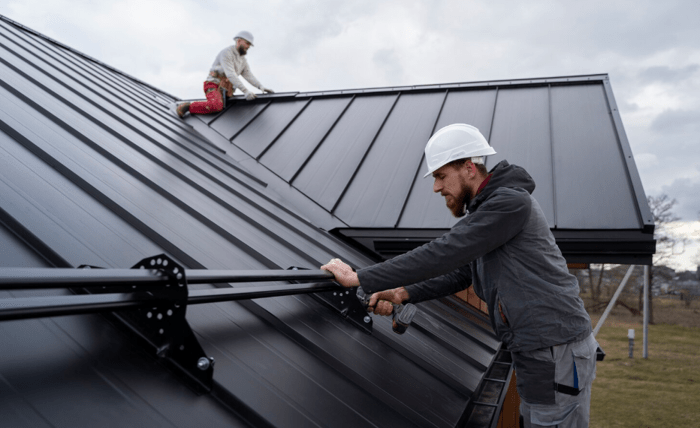Slate roofs are widely admired for their durability, aesthetic appeal, and environmental friendliness. Known for their natural beauty and longevity, slate tiles can last over a century when properly installed and maintained. While the upfront cost of slate roofing can be high, the long-term benefits make it an attractive investment for homeowners seeking a timeless and resilient roofing solution. This guide provides a comprehensive overview of installing and maintaining slate roofs, from planning and installation to routine care and repairs.
Understanding Slate Roofing
Slate is a fine-grained metamorphic rock that splits easily into thin, flat sheets, making it ideal for roofing. Its natural composition gives it resistance to fire, water, and harsh weather conditions. Slate roofs come in various colors, including gray, green, purple, and black, allowing homeowners to choose an option that complements their architectural style. Beyond aesthetics, slate roofs provide excellent insulation, energy efficiency, and require minimal maintenance compared to other roofing materials. Investing in durable slate roofing ensures a long-lasting, high-quality roof that enhances both the value and appearance of your home.
Planning Your Slate Roof Installation
Before installing a slate roof, careful planning is essential. Slate is considerably heavier than standard roofing materials, typically weighing between 800 and 1,500 pounds per square (100 square feet). This weight requires a strong roof structure capable of supporting the load. A structural engineer may be needed to assess the building’s framework, particularly in older homes.
It’s also important to choose high-quality slate. Natural slate varies in thickness, size, and color, affecting both performance and appearance. Premium-grade slate has fewer imperfections, ensuring durability and uniformity. Additionally, selecting the right installation method—such as traditional copper nails or modern stainless steel fasteners—is crucial for ensuring longevity.
Tools and Materials Needed
Installing a slate roof requires specialized tools and materials:
- Slate tiles: Available in various sizes, thicknesses, and grades.
- Roofing nails: Copper or stainless steel recommended to prevent rust.
- Slate ripper: Used to remove damaged tiles.
- Chalk line: For precise alignment.
- Hammer and roofing shovel: Standard roofing tools.
- Underlayment: Provides an additional waterproof barrier.
- Flashing materials: Typically copper or lead for chimneys and valleys.
- Safety gear: Harnesses, gloves, and non-slip footwear.
Proper preparation and high-quality tools are critical to avoid costly mistakes during installation.
Step-by-Step Slate Roof Installation
1. Preparing the Roof
Start by removing any old roofing materials and inspecting the roof deck for damage. Reinforce the structure if necessary. Install a high-quality underlayment, such as synthetic roofing felt, to provide an extra layer of protection against water infiltration.
2. Laying the Starter Course
The starter course is the first row of slate tiles at the roof edge. Align the tiles carefully using a chalk line, ensuring overhangs are uniform. This course sets the foundation for the entire roof, so precision is essential.
3. Installing Slate Tiles
Begin installing the main slate courses from the bottom edge upward. Secure each tile with two nails positioned slightly above the exposure line. Stagger the tiles to prevent aligned seams, which enhances water resistance. Cut tiles with a slate cutter or hammer for precise fitting around chimneys, vents, and valleys.
4. Flashing and Valleys
Install flashing in valleys, around chimneys, and along roof edges to prevent leaks. Copper or lead flashing is preferred for slate roofs due to its durability and compatibility with natural stone.
5. Finishing Touches
Once all tiles are in place, inspect the roof for alignment, loose nails, or broken tiles. Clean the roof surface and remove any debris. A professional inspection is recommended to ensure all installation standards are met.
Maintaining a Slate Roof
Proper maintenance is key to maximizing the lifespan of a slate roof. Unlike asphalt shingles, slate rarely needs replacement, but it still requires attention to prevent small issues from escalating.
1. Regular Inspections
Conduct roof inspections at least twice a year and after major storms. Look for cracked, chipped, or missing tiles, as well as any signs of water infiltration in the attic.
2. Cleaning
Remove moss, leaves, and debris that can trap moisture and accelerate deterioration. Avoid pressure washing, which can damage the tiles. Instead, gently brush debris off using a soft broom.
3. Repairing Damaged Slate
If a slate tile is cracked or broken, replace it promptly to prevent leaks. Use a slate ripper to remove the damaged tile and slide a new one into place, securing it with copper or stainless steel nails. For extensive damage, consult a professional roofer experienced in slate work.
4. Maintaining Flashing and Gutters
Inspect flashing around chimneys, vents, and valleys for corrosion or damage. Ensure gutters and downspouts are clear to prevent water backup that could compromise the roof structure.
5. Avoid Walking on the Roof
Slate is brittle and can crack under weight. Use roof ladders or scaffolding when necessary, and limit walking on the roof as much as possible.
Benefits of Professional Installation
While DIY installation is possible for small projects, hiring an experienced slate roofer is highly recommended. Professional installers understand the precise techniques required for secure fastening, proper alignment, and effective flashing installation. Skilled installation reduces the risk of leaks, structural damage, and premature slate failure.
Conclusion
Slate roofs combine elegance, longevity, and sustainability, making them an excellent choice for homeowners looking to invest in a durable roofing solution. Proper planning, careful installation, and routine maintenance are essential to enjoy the full benefits of a slate roof for decades. From assessing structural support to selecting quality materials and performing timely inspections, each step ensures that the roof remains a stunning and functional feature of the home. With the right care, a slate roof can provide unmatched beauty and protection for over a century, making it a worthwhile investment in both aesthetics and long-term value.

Singh is an experienced spiritual writer and the resident author at Guruvanee.com. With a deep passion for exploring the mystical aspects of life, Singh delves into various spiritual traditions, philosophies, and practices to inspire readers on their spiritual journeys.

